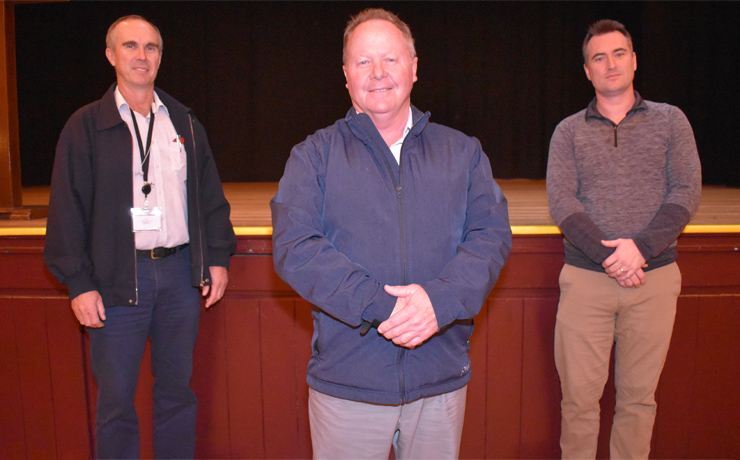
December 21, 2020
Phase 2 of the $2 million Burnett Water Feasibility Study – the “Options Analysis” – has been released, inching forward the eventual construction of the much-discussed Barlil Weir on Barambah Creek.
The study, funded by the Federal Government’s National Water Infrastructure Development Fund, has been examining solutions to increase the water supply in the South and North Burnett regions.
Phase 1 was completed earlier this year. This “Strategic Business Case” identified more than 20 options to potentially achieve increases in water supply and security across the two regions.
Phase 2 was a structured assessment to refine these options, considering factors such as economic performance, social impact and affordability.
Phase 3 will work on the recommendations from Phase 2.
* * *
South Burnett
In the South Burnett, the key recommendations from Phase 2 include:
- Constructing a re-regulating weir on Barambah Creek (Barlil Weir)
- A State Government review to optimise water access rules to support agricultural supply chain improvements.
Also recommended was the “South Burnett Integrated Water Initiative”.
South Burnett Mayor Brett Otto said this included:
- Investigating a permanent transfer of high priority water from the Tarong Power Station to secure the urban water supply for Kingaroy;
- Securing a combination of private and public investment for the construction of a water recycling plant at Swickers in Kingaroy;
- Examining the viability and process of converting Gordonbrook Dam from urban to irrigation use; and
- Securing additional water for irrigators in Blackbutt, to be transported through the Wivenhoe pipeline.
Mayor Otto said the Burnett Water Feasibility Study was an independent assessment of the options to increase water supply and security across the two local government areas.
“Following a high-level assessment which confirmed all options for the South Burnett as feasible, detailed assessment was used to rank and order the projects, with a number of short-listed projects being carried through for more detailed consideration,” he said.
“These projects were further considered against issues such as social impact, environmental parameters, sustainability and economic benefits.
“This work recently completed by the project consultants, Jacobs, addresses project cost and benefit as well as job creation of each of the projects.
“Council supports these recommendations and as the next phase of the project, proposes to jointly fund the preparation of a 25-year Economic Roadmap to provide strategic direction for the South Burnett, preparing and managing strategic water opportunities,” Mayor Otto said.
He said the next phase was due to begin in early 2021.
* * *
Barlil Weir Project
The Options Analysis details the next steps required to assess the viability of this project:
- Conduct demand and willingness to pay assessment with prospective water customers – approximately 2 months – estimated $60,000-$80,000
- Consultation with Sunwater – approximately 2 months – $50,000-$100,000
- Updated or new environmental approvals – 3 months – $50,000 to $300,000
- Detailed Business Case – 9 to 12 months – $2.2-$2.74 million
- Environmental Impact Statement – 9-15 months – $2.5 million (this could be less if a full EIS is not required)
- Native Title and cultural heritage – 9-15 months – $250,000
- Post-Detailed Business Case and pre-construction activities – 12 months – $1.9-$2.7 million
* * *
North Burnett
In the North Burnett, the Phase 2 recommendations focus on pursuing a detailed business case for a re-regulating weir on the Boyne River and for water planning for Coalstoun Lakes.
The Federal Government has already committed a further $1.5 million for the Coalstoun Lakes Irrigation Pipeline Study.
Federal Member for Flynn Ken O’Dowd said the completion of the study and findings were great news for farmers in the region.
“The study examined a range of options and identified solutions to increase water supply that would underpin an expansion of irrigated agriculture, delivering new jobs and economic growth in the North and South Burnett regions,” Mr O’Dowd said.
- Download Burnett Water Feasibility Study Options Analysis (19.45MB PDF)
External links:
Related articles:
- Parties Urged To Match Weir Promise
- LNP Vows To Build Barlil Weir
- MP Has Hopes For Weir Project
- Water Study Identifies Key Projects
- Water Study Highlights Blackbutt
- Meeting To Distill Water Options
- Burnett Water Study Begins
- Extra $1.5m For Water Study
- Department To Lead Water Study
- Water Infrastructure Study Inches Ahead
- Mayor Calls Water Meeting
- Consultant Tipped For Water Project
- Great Ideas … Just Add Water
- Water Meeting On Thursday
- Council To Consult Widely On Water Projects
- $2m Study To Improve Irrigation























